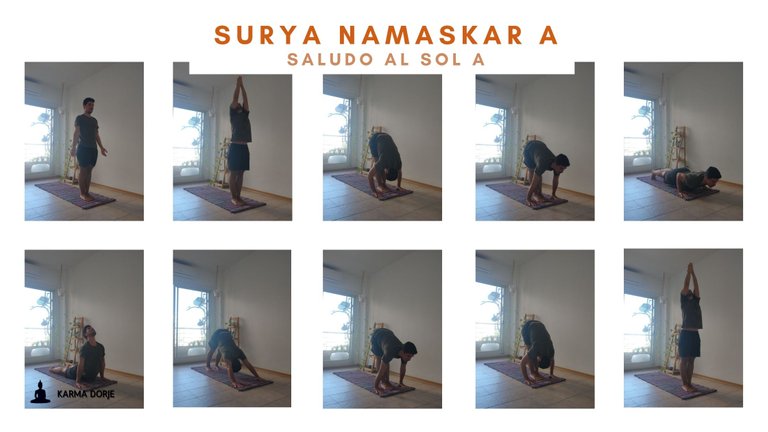
Sun salutation A by @karmadorje
No importa lo profundo que llegues en una postura; lo que importa es cómo respiras cuando estás ahí.
Muchas personas hoy en día, debido a esta pandemia, han tenido la necesidad de comenzar con la práctica de meditación o de Yoga, desde sus casas. En muchas ocasiones buscando la guía de una persona calificada, otras veces guiandose únicamente por videos que no pueden acompañarlos en su proceso (cosa que es muy importante), y una gran cantidades de casos donde la persona aprende sola, sin guía, sin referencia, sin un acompañamiento de ningún tipo.
Como enseñante de Yoga, he visto todos los casos a lo largo de todos estos años. Incluso, yo estuve en algunas de esas etapas antes y me habría gustado ciertas indicaciones o ayudas en los momentos de "autodidacta" que me habría permitido cuidarme y avanzar de manera mucho más armoniosa de lo que realmente fue. Sin embargo, puedo decir, que todo terminó resultando bien de igual forma. Pero si quisiera aportar algo de ayuda a partir de la serie de posteos que pienso ir publicando a partir de ahora, a aquellas personas que puedan interesarse en la práctica de Yoga-asanas (la práctica postural del yoga), y por supuesto, me pongo a disposición, para cualquier duda que tengan.
It doesn't matter how deep you go in a posture; what matters is how you breathe when you are there.
Many people today, because of this pandemic, have had the need to start with the practice of meditation or Yoga, from their homes. Many times seeking the guidance of a qualified person, other times guided only by videos that can not accompany them in their process (which is very important), and a large number of cases where the person learns alone, without guidance, without reference, without an accompaniment of any kind.
As a Yoga teacher, I have seen all the cases throughout all these years. Even, I was in some of these stages before and I would have liked some indications or help in the moments of "self-taught" that would have allowed me to take care of myself and to advance in a much more harmonious way than it really was. However, I can say that everything turned out well anyway. But I would like to provide some help from the series of posts that I plan to publish from now on, to those people who may be interested in the practice of Yoga-asanas (the postural practice of yoga), and of course, I am at your disposal for any questions you may have

En un posteo anterior, les compartía una preparación apta para cualquier tipo de práctica de Yoga-Asanas que quieras realizar, muy corta y muy fácil de recordar, puedes echarle un ojo Aquí en este link.
Ahora, el día de hoy y como una forma de continuación de tu práctica como principiante, les comparto el Surya Namaskar A, que se traduce como las Salutaciones al Sol A.
Aclaración: Es posible hacer la preparación y como podrán ver en el post anterior, la última postura de la preparación es Samasthitih, de modo que es la postura de enlace para poder continuar con estas salutaciones que hoy vamos a aprender.
El Surya Namaskar, consta de 9 movimientos unidos a la respiración (sistema de vinyasa) y una postura donde se permanece inmovil por 5 respiraciones -Adho Mukha Svanasana-.
Los Vinyasas son esos movimientos que se realizan en simultáneo con los momentos de inhalación y exhalación, hacia arriba y hacia abajo, respectivamente. Y son de GRAN importancia hacerlos correctamente durante la práctica de asanas, para conseguir los beneficios completos de cada una de las posturas.
«Vina vinyasa yogena asanadin na karayet – Oh yogui, no hagas asana sin vinyasa» - se explica en el Yoga Korunta.
En este sentido, el saludo al sol es perfecto, porque enseña correctamente al practicante, a través de su desarrollo repetido, a conectar correctamente con el Vinyasa -movimiento y respiración- y permitiendo así transformar la práctica de asanas en una meditación en movimiento.
En el momento de la permanencia, como es habitual en el Ashtanga Yoga, la postura se sostiene sin movimiento por un total de 5 respiraciones, para luego proseguir con el vinyasa.
Dicho todo esto, les detallo cada una de las posturas, y al final, un gif para entender el encadenamiento de posturas que debe realizarse.
NOTA: Esta secuencia, podría repetirse diez veces seguidas, luego de haber hecho la preparación mencionada antes aquí. Y luego, el practicante se acuesta totalmente en la alfombra o en el suelo, y descansa durante 5 a 10 minutos.
In a previous post, I shared with you a preparation suitable for any type of Yoga-Asana practice you want to do, very short and very easy to remember, you can take a look at Here in this link.
Now, today, as a continuation of your practice as a beginner, I share with you the Surya Namaskar A, which translates as the Sun Salutations A.
Clarification: It is possible to do the preparation and as you will see in the previous post, the last posture of the preparation is Samasthitih, so it is the linking posture to be able to continue with these salutations that we are going to learn today.
The Surya Namaskar, consists of 9 movements linked to the breath (vinyasa system) and a posture where you remain immobile for 5 breaths -Adho Mukha Svanasana-.
The Vinyasas are those movements that are performed simultaneously with the moments of inhalation and exhalation, upward and downward, respectively. And they are of GREAT importance to do them correctly during asana practice, in order to get the full benefits of each of the postures.
Vina vinyasa yogena asanadin na karayet - Oh yogi, do not do asana without vinyasa" - is explained in the Yoga Korunta.
In this sense, the sun salutation is perfect, because it correctly teaches the practitioner, through its repeated development, to correctly connect with Vinyasa - movement and breath - and thus allowing to transform the asana practice into a meditation in movement.
At the moment of permanence, as is usual in Ashtanga Yoga, the posture is held without movement for a total of 5 breaths, to then continue with vinyasa.
Having said all this, I detail each of the postures, and at the end, a gif to understand the chaining of postures to be performed.
NOTE: This sequence could be repeated ten times in a row, after having done the preparation mentioned above here. And then, the practitioner lies fully on the mat or on the floor, and rests for 5 to 10 minutes.

Surya Namaskar A:
Empezamos estando de pie en: Samasthitih, con la mirada fija a 45° hacia un punto en el suelo. Esta es el inicio y el final de toda la secuencia.
Pies juntos, pecho abierto y brazos a los costados.
We begin by standing in: Samasthitih, with our gaze fixed at 45° to a point on the floor. This is the beginning and end of the whole sequence.
Feet together, chest open and arms at the sides.

1- Ekam - Inhalando:
Elevamos brazos hacia el techo y juntamos palma de manos, mirando hacia sus puntas, y estirando todo el cuerpo.
1- Ekam - Inhaling:
We raise our arms towards the ceiling and join the palms of our hands, looking towards the tips of our hands and stretching the whole body.
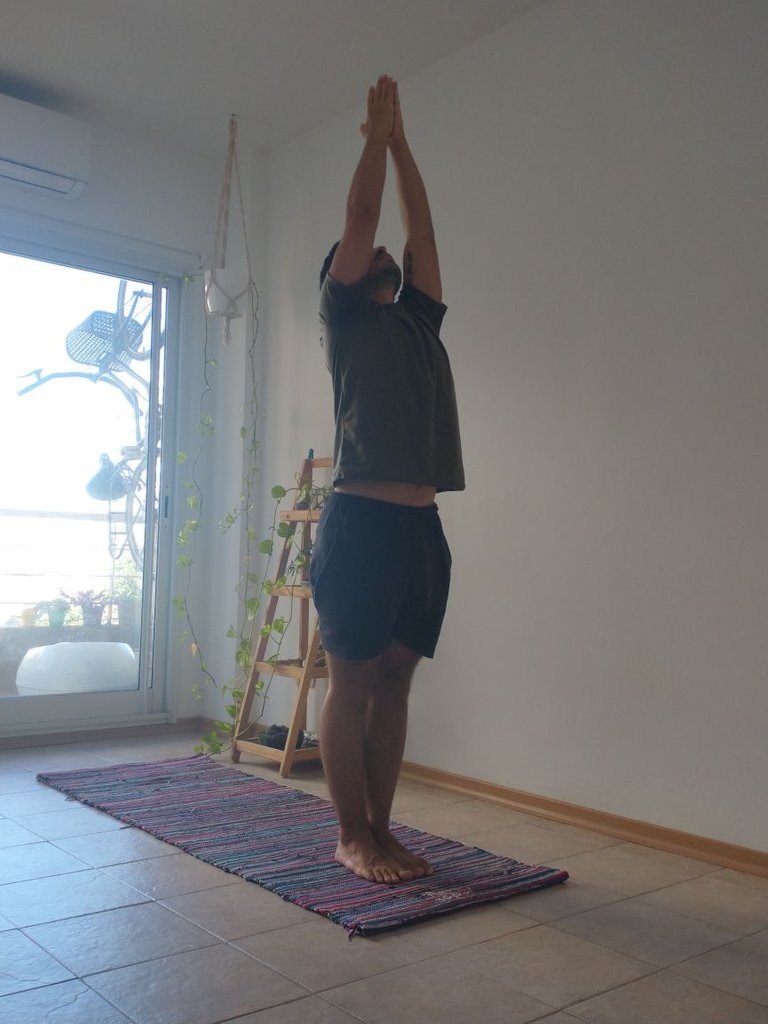
2- Dwe - Exhalando:
Bajamos el tronco, plegándonos sobre las piernas, con cabeza hacia los pies y las manos en el suelo a los lados de las piernas.
Si esta postura es muy difícil al principio, podemos flexionar ligeramente las rodillas.
2 - Dwe - Exhaling
We lower the trunk, folding over the legs, with the head towards the feet and the hands on the floor at the sides of the legs.
If this posture is too difficult at first, we can slightly bend our knees.

3- Trini - Inhalando:
Elevamos la cabeza y abrimos el pecho, siempre permaneciendo las manos apoyadas en el piso y a los lados de los pies.
Si esta postura es muy difícil al principio, podemos flexionar ligeramente las rodillas.
3 - Trini - Inhaling:
We raise our head and open our chest, always keeping our hands on the floor and on the sides of our feet.
If this posture is too difficult at first, we can slightly bend our knees.
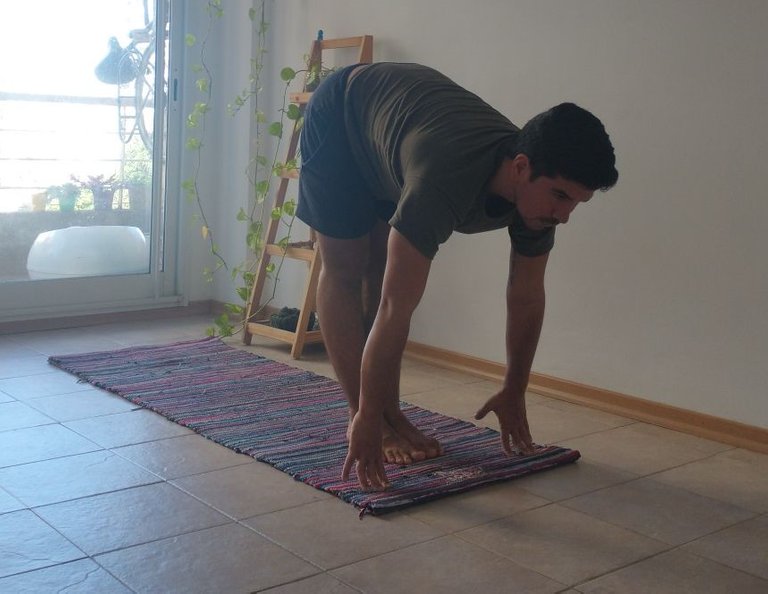
4- Chatuari - Exhalando:
Movemos los pies hacia atrás y bajamos, flexionando los codos, intentando descender todo el cuerpo paralelo al piso.
Si esta postura es muy difícil al principio, podemos flexionar las rodillas, apoyándolas en el suelo y subiendo la cadera como se muestra en la figura B.
4- Chatuari - Exhaling:
We move our feet backwards and descend, bending our elbows, trying to lower the whole body parallel to the floor.
If this posture is too difficult at first, we can bend the knees, resting them on the floor and raising the hips as shown in figure B.

Figura A

Figura B
5- Pancha - Inhalando:
Cambiando la posición de los pies para apoyar los empeines, estiramos los brazos, elevando la cabeza hacia el techo, mientras el pecho se abre con la espalda arqueada. Las piernas están activas y elevadas del suelo (no hacen contacto con el piso; Postura del perro cabeza arriba -Urdvha Mukha Svanasana-).
Si esta postura es muy difícil al principio, podemos apoyar las piernas y la cadera en el piso, mientras estiramos los brazos (postura de la cobra - Bhujangasana-).
5- Pancha - Inhaling:
Changing the position of the feet to support the insteps, we stretch the arms, raising the head towards the ceiling, while the chest opens with the back arched. The legs are active and elevated off the floor (they do not make contact with the floor; Upward Dog Posture -Urdvha Mukha Svanasana-).
If this posture is too difficult at the beginning, we can rest the legs and hips on the floor, while stretching the arms (Cobra Pose - Bhujangasana-).
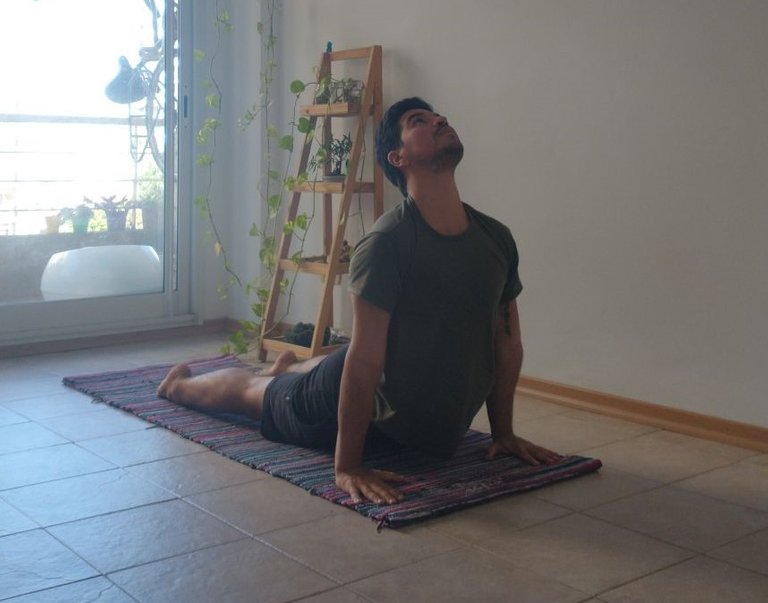
6- Shat - Exhalando:
Postura del perro cabeza hacia abajo -Adho Mukha Svanasana-
Esta es la permanencia de cinco (5) respiraciones.
Cambiando nuevamente los pies, para apoyar las plantas de pies, estiramos brazos y piernas elevando la cadera hacia el techo con la cabeza hacia abajo y la mirada entre los pies.
Manten los brazos firmes y empujando el suelo con las manos, para lograr llevar el peso hacia los pies, y eventualmente los talones puedan llegar al suelo (toma tiempo, sin afán).
Si esta postura es muy difícil al principio, podemos flexionar ligeramente las rodillas. Manteniendo el empuje de los brazos hacia los pies.
6- Shat - Exhaling:
Head Downward Dog Pose -Adho Mukha Svanasana-.
This is the five (5) breath stay.
Shifting the feet again, to support the soles of the feet, stretch the arms and legs raising the hips towards the ceiling with the head down and the gaze between the feet.
Keep the arms firm and pushing the floor with the hands, to get the weight towards the feet, and eventually the heels can reach the floor (it takes time, without eagerness).
If this posture is too difficult at first, we can slightly bend the knees. Keeping the push of the arms towards the feet.
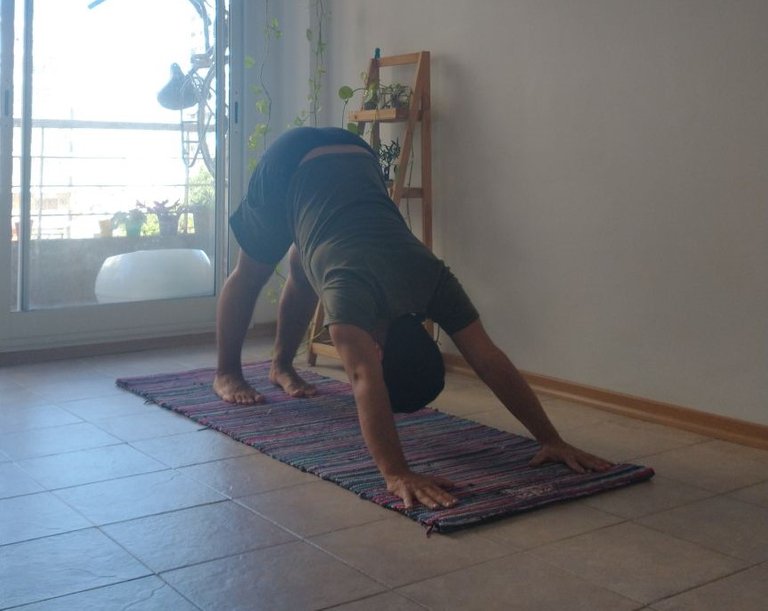
7- Sapta - Inhalando:
Elevamos la cabeza y abrimos el pecho, siempre permaneciendo las manos apoyadas en el piso y a los lados de los pies.
Si esta postura es muy difícil al principio, podemos flexionar ligeramente las rodillas.
Si nos fijamos, esta postura coincide con 3- Trini, pues estamos haciendo el camino de regreso a Samasthitih para cerrar el ciclo.
7- Sapta - Inhaling:
We raise our head and open our chest, always keeping our hands resting on the floor and on the sides of our feet.
If this posture is too difficult at first, we can slightly bend our knees.
If we notice, this posture coincides with 3- Trini, as we are making our way back to Samasthitih to close the cycle.

8- Ashtau - Exhalando:
Bajamos el tronco, plegándonos sobre las piernas, con cabeza hacia los pies y las manos en el suelo a los lados de las piernas.
Si esta postura es muy difícil al principio, podemos flexionar ligeramente las rodillas.
Si nos fijamos, esta postura coincide con 2- Dwe, pues estamos haciendo el camino de regreso a Samasthitih para cerrar el ciclo.
8- Ashtau - Exhaling
We lower the trunk, folding over the legs, with the head towards the feet and the hands on the floor at the sides of the legs.
If this posture is too difficult at first, we can slightly bend our knees.
If you notice, this posture coincides with 2- Dwe, as we are making our way back to Samasthitih to close the cycle.

9- Nava - Inhalando:
Elevamos brazos hacia el techo y juntamos palma de manos, mirando hacia sus puntas, y estirando todo el cuerpo.
Si nos fijamos, esta postura coincide con 1- Ekam, pues estamos haciendo el camino de regreso a Samasthitih para cerrar el ciclo.
9- Nava - Inhaling:
We raise our arms towards the ceiling and join the palms of our hands together, looking towards their tips, and stretching the whole body.
If we notice, this posture coincides with 1- Ekam, as we are making our way back to Samasthitih to close the cycle.
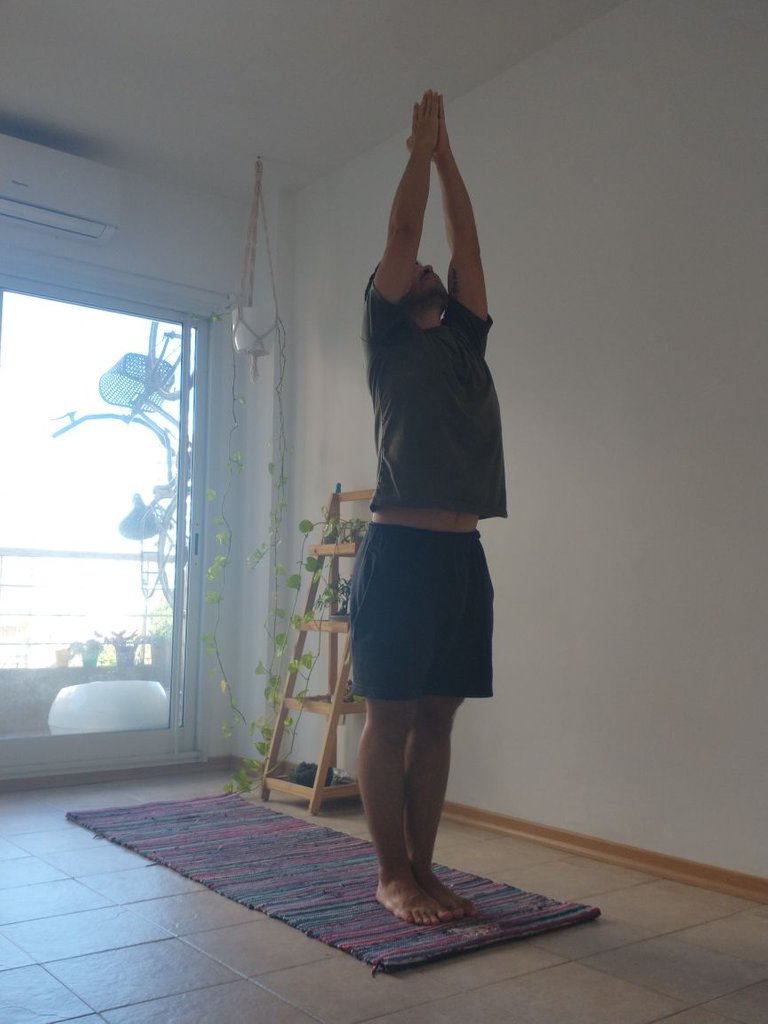
Samasthitih
Volvemos a donde empezamos.
Con la mirada fija a 45° hacia un punto en el suelo. Esta es el inicio y el final de toda la secuencia.
Pies juntos, pecho abierto y brazos a los costados.
Samasthitih
We go back to where we started.
With our gaze fixed at 45° to a point on the floor. This is the beginning and end of the whole sequence.
Feet together, chest open and arms at your sides.

Como les mencioné antes, esta secuencia podría repetirse diez veces seguidas, luego de haber hecho la preparación mencionada antes. Y luego, el practicante se acuesta totalmente en la alfombra o en el suelo, y descansa durante 5 a 10 minutos sin moverse.
As I mentioned before, this sequence could be repeated ten times in a row, after having done the preparation mentioned before. And then, the practitioner lies down completely on the mat or on the floor, and rests for 5 to 10 minutes without moving.
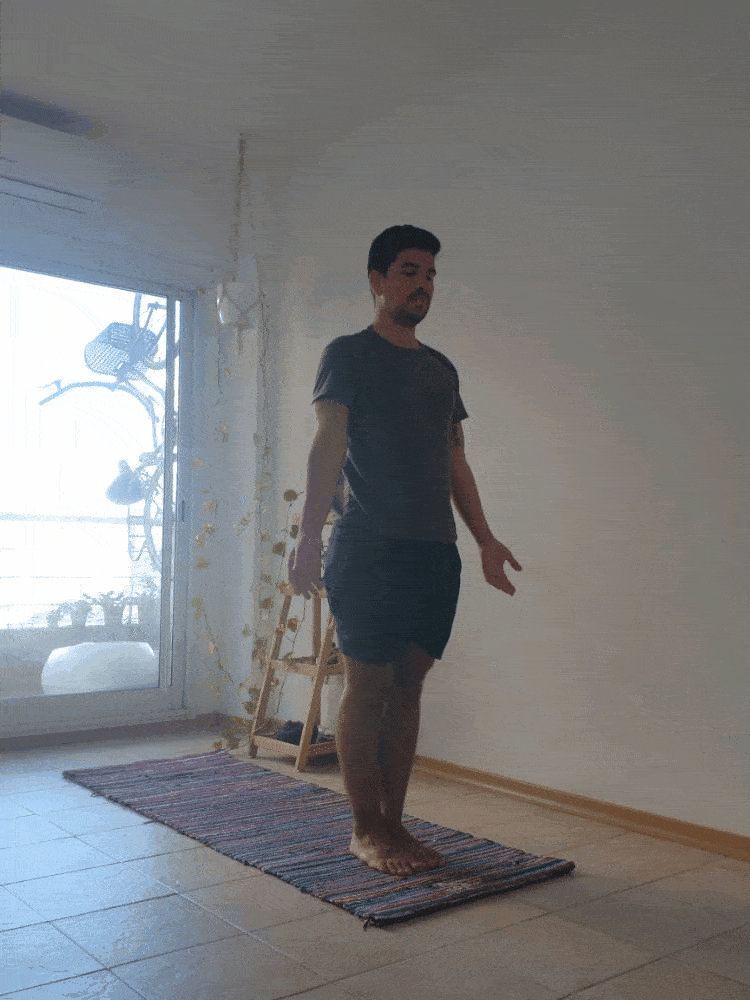
Quedo a la orden para cualquier duda sobre la ejecución del Surya Namaskar A. Recuerda que aunque es interesante realizar la práctica solos, es importante tener una guía adecuada para el completo entendimiento de la técnica y de las consecuencias que van surgiendo de su realización.
I remain at your disposal for any doubt about the execution of the Surya Namaskar A. Remember that although it is interesting to perform the practice alone, it is important to have a proper guide for the complete understanding of the technique and the consequences that arise from its realization.

Soy Julio Cesar Arvelo, practicante y profesor de Ashtanga Yoga y Meditación.
- Si te gustó este post y quieres seguir leyéndome, bienvenido a seguirme.
- Todas las imagenes han sido capturadas por @garcianieto
I am Julio Cesar Arvelo, practitioner and teacher of Ashtanga Yoga and Meditation.
- If you liked this post and want to keep reading me, welcome to follow me.
Mi redes sociales:

MINDFUL LIFE is a Natural Medicine project which supports meditators on HIVE
Discord II Community
Hola @karmadorje que lindo te quedo el post, las imágenes muy claras y el gifs perfecto. Muy bonito, 👍🙏 gracias por hacer un buen trabajo.
Saludos y que esté post llegue a todos los que lo necesiten, gracias Julio Cesar. 🤗😉
Muchas gracias!! @soyunasantacruz ojala que si, puedan muchos beneficiarse con esta publicacion
Oh I love sun salutation. It was one of the first things I learned from my yoga book. What I was unable to learn though , was the correct breathing. It wasnt until my friend gave me a lesson that this was explained.
What I love about your post is how well you explain the breathing for each posture.
Thank you so much for putting this out there. Much love to you @karmadorje 💚🤗
Yes, breathing is a very important topic for me in my teaching. I'm glad you enjoyed it.
Best regards
Son unas buenas fotos, y es una explicación muy sencilla referente a una postura. Es una buena forma de enseñar y si es algo más complicado darles la opción de hacerlo más fácil. Gracias por compartir 😊